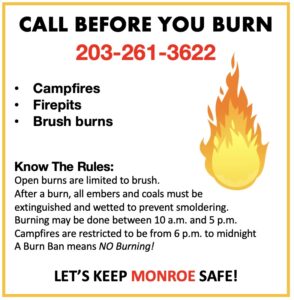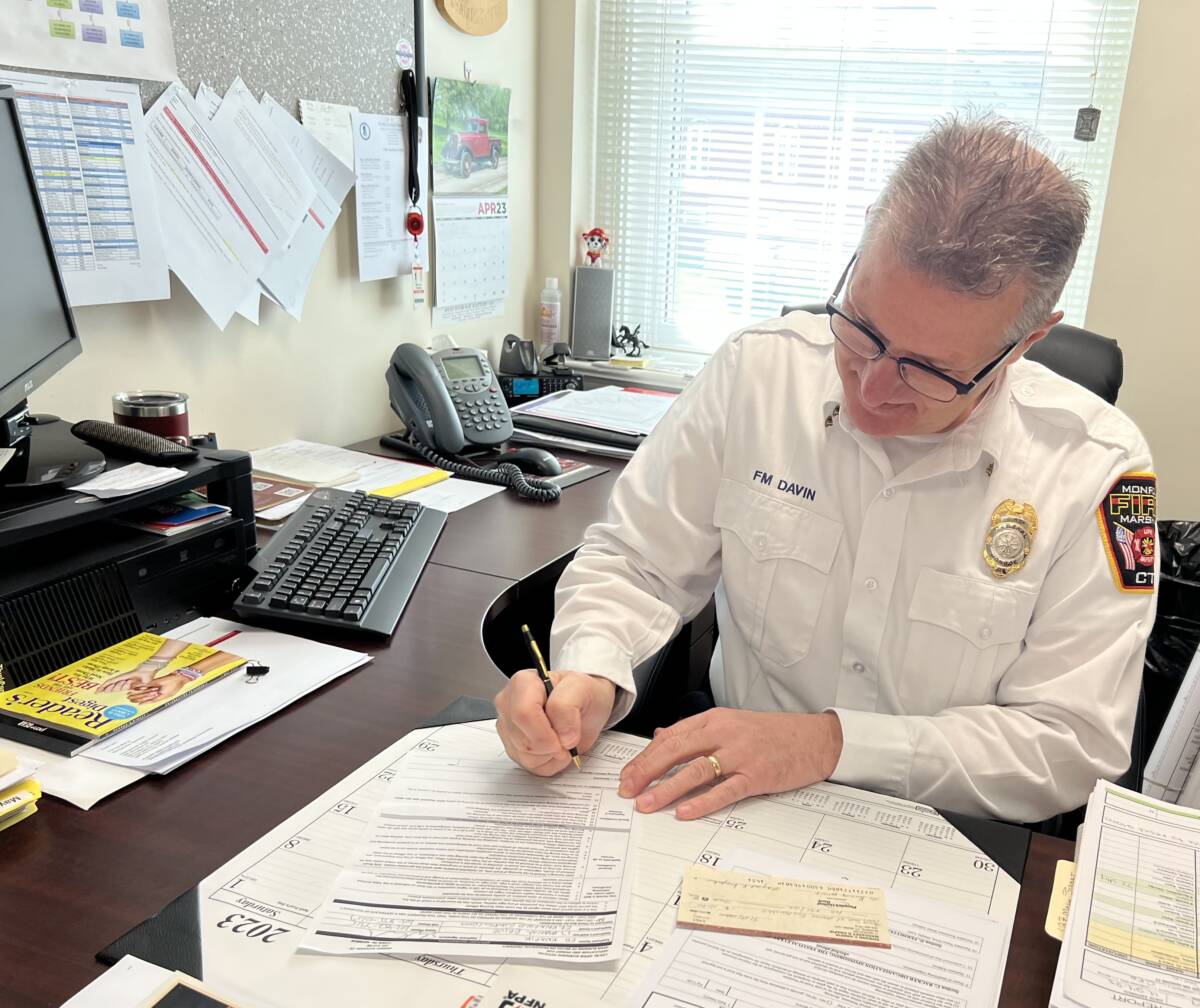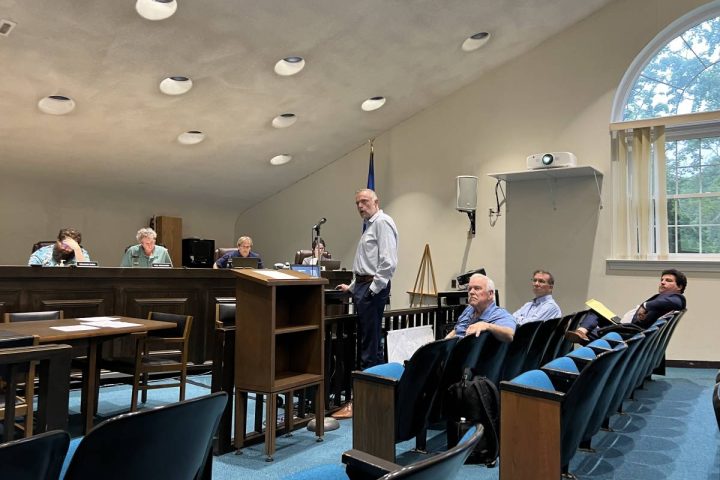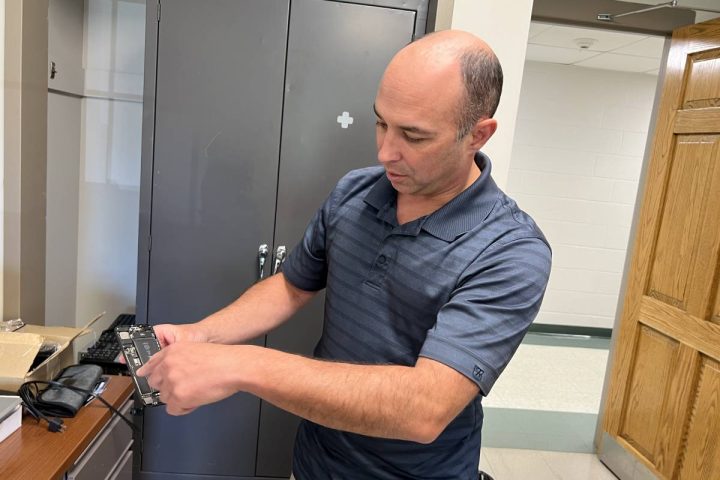A Sandy Hook resident burning debris in a backyard sparked a massive brush fire on April 11, burning 15 acres of terrain along the Algonquin pipeline station property to the east.
Among about 75 firefighters from five towns who extinguished the fire, a tanker and a brush truck from the Stevenson Volunteer Fire Department in Monroe joined the response.
The incident occurred the same day local, state and federal officials announced a Red Flag Warning that warm temperatures, low humidity and strong winds were expected to combine to produce an increased risk of fires.
“April is always a sketchy month with open burns,” Monroe Fire Marshal William “Bill” Davin said during an interview in his Monroe Town Hall office Monday morning. “Grass and weeds start growing. It can be breezy and the tops of tall grasses and leaves can dry out.”
Davin said a brush fire can sometimes spread to the roots of a tree and go underground, where it burns and comes up to another tree, which is what happened in Newtown.
“There have been none in Monroe, thank goodness,” he said.
The Connecticut Department of Energy and Environmental Protection has a forestry unit that joined the response in Sandy Hook. Davin said it uses a mini excavator to dig up an area during these types of brush fires.
Though the exposure to oxygen stokes the flames, he said it makes it easier to locate the fire and put it out.
“The sad part about it is a lot of these fires were started by humans emptying wood stove ashes or grills,” he said. Davin said embers can stay hot for several days and it only takes one to start a fire under dry conditions.
Open burn, campfire permits

Davin said some fires are caused by illegal burns when residents don’t know they need a permit. The Monroe Fire Marshal’s Office issues open burn and campfire permits to promote fire safety.
Open burn permits, which are for brush, cost $10 and are good for one calendar year, and campfire permits, which are free, are also good for the year.
Permit applications can be downloaded on the Fire Marshal page of the town’s website.
Campfire permits can be applied for online, but applicants of open burn permits have to come to Monroe Town Hall for payment.
Ed Knapik, who has taken out an open burn permit for the past 30 years, came in with a new one for Davin to sign Monday morning.
“We’re surrounded by woods,” he said. “Every year, I have a big pile of tree limbs and brush.”
Knapik said the permit process is easy.
Davin said Knapik’s permit was the 91st one he issued this year, adding he knows who most of the regular open burn permittees are.
Regulars like Knapik just fill out the form and, if it’s open burn instead of a campfire permit, pay the $10. But people from Davin’s office visit new applicants’ properties to ensure proper protections are in place.
“My office can guide them,” Davin said. For instance, he said a campfire or a burn should not be set on the edge of a wooded area.
An open burn is permitted from 10 a.m. to 5 p.m. and a campfire from 6 p.m. to midnight.
“I recommend a campfire permit for a fire pit,” Davin said. “It can prevent nuisance calls for the fire department if we know a certain address has a permit.”
Though a resident has a permit, it is still illegal to burn on a day that is too windy or too dry. On the day of a burn, permit holders must call the Monroe Police Department’s nonemergency line, 203-261-3622, to find out if weather conditions are okay.
Calling the police department on the day or an open burn or campfire also helps to avoid nuisance calls for the town’s fire departments, Davin said, adding when someone sees smoke and dials 911, public safety officials will already know about the permitted burn in the area.
The Monroe Fire Marshal’s Office takes direction from the Connecticut Department of Energy and Environmental Protection, which sends out a daily email on the Forest Fire Danger level. On Monday, it was low.
The daily Forest Fire Danger level can be found at this link.
Dos and don’ts
An open burn is larger than a campfire burn.
“You can’t burn leaves. No grass, leaves, furniture or plastics,” Davin said. “An open burn is sticks, limbs and branches up to two-to-three inches in diameter. An open burn is a free burning fire emitting a small amount of smoke.”
An open burn can only be done on a residentially zoned property where the permittee resides.
A burn cannot be left unattended and precautions should be taken first, including the clearing of grass and trees in the burn area, wetting down the surrounding area and placing fire extinguishers and a garden hose nearby.
When a burn is over, all embers and coals must be extinguished and wetted.
The campfire permit form says none of the following items may be burned: garbage, trash, furniture, plastics, paper, cardboard, no painted or pressure treated woods, no hazardous chemicals, liquids, solids, gels or gasses.
Being a good neighbor
Davin suggests asking your neighbors if they have an issue with you doing a burn before applying for a permit.
“They might have breathing issues,” he said, adding his office can guide permit applicants on the best spots to have a campfire or open burn on their property.
All respectful comments with the commenter’s first and last name are welcome.






